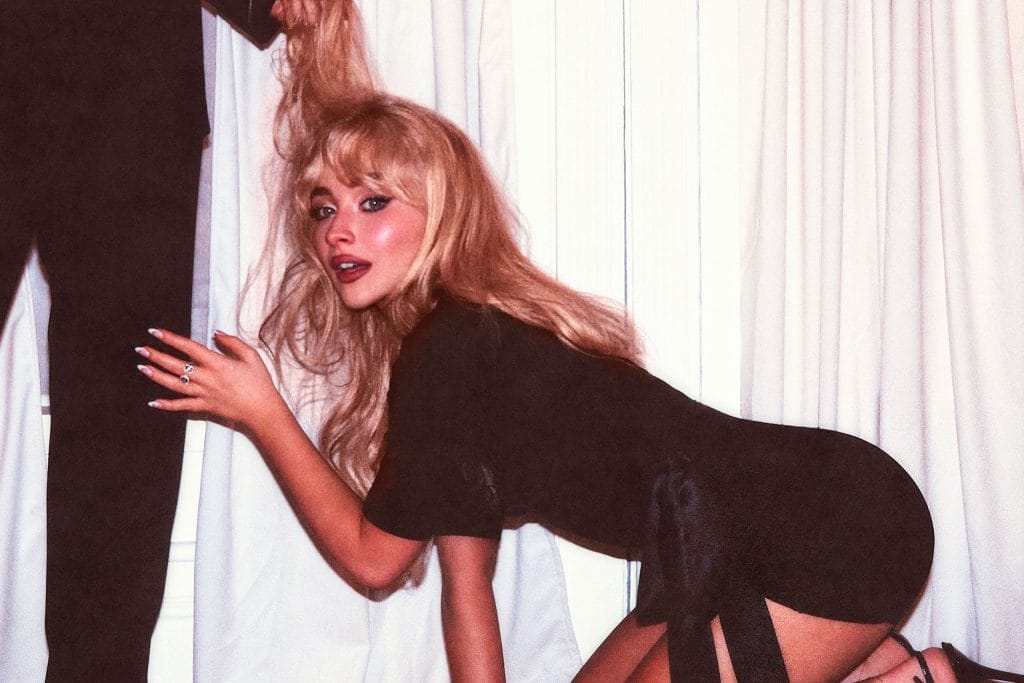Whether we grew up as avid readers or not, most of us are familiar with the often-repeated advice of never judging a book by its cover. While one might argue that the era of books and reading might just have come to an end, the popular adage is far more significant in the times of social media, where sometimes the cover is all we really get. The value of the image is indisputable today, and popular social platforms increasingly thrive on a mass judge-the-cover phenomenon. What the image reveals to you in a cursory, first glance is also what the final message of its content has come to mean. The internet’s newest pop-culture debate has highlighted an easy example of this phenomenon. Less than a week ago, American pop sensation Sabrina Carpenter announced her upcoming album, slated for release by this month’s end, with an Instagram post revealing its cover and title. The post quickly racked up over 4.5 million likes and nearly 80,000 comments.

But not all of this attention has been aimed at an anticipation of the album’s release, or an exaltation of Carpenter’s work. Many have taken to the internet to call the pop star’s choices ‘irresponsible’ and ‘distasteful’, sparking widespread controversy and debate that, despite the internet’s notoriously short attention span, shows no signs of fading. But precisely what has been taken offence at? How did a beloved internet darling fall from grace so fast? Why has this image struck such a sensitive nerve? Where exactly did this whole debacle begin?
Judging the (album) cover
Carpenter’s new album cover playfully features her on all fours, in a little black dress, reaching out to grab (what is presumably) a man’s leg, as he holds a fist full of her platinum blonde hair. All this while, Carpenter looks dead on at the camera, with her lips curled slightly upward into what seems to be a small, knowing smirk.
Commentary has been bandwagoned into essentially two separate camps: one that insists that Carpenter’s sexual iconography be interpreted as satire, while the other claims that it does not matter whether this was intended to be satire or not, and that the impact it has is violent, regardless.
Almost fashioned as a homage to the vintage, softcore aesthetic of pin-up eroticas, the image is shot and edited to retain the look of old-school film and VHS tapes. Carpenter’s figure occupies most of the frame, with the fragmented body of the presumed man only visible toward the far edges of the screen. This image is accompanied by another close-up of a baby-blue collar attached to the body of a small, furry dog. It bears the words, ‘Man’s Best Friend’, in a looping font: the name of her upcoming album in question.
The post followed on the release of the first track from the album, titled ‘Manchild’, which features, in classic Carpenter style, a little bit of synth and a great deal of sass as the pre-chorus brands men ‘stupid’ and ‘slow’. But the music and her song track have hardly seemed to matter when it comes to the contours of this internet controversy, with most of the arguments starting and ending with the image itself. Comments under the Instagram post range from support and excitement to righteous anger and betrayal:
Given the 31,000 likes, it’s definitely not just Miri!
Pardon my tongue-in-cheek, but the man is quite literally off-centre in this frame, Elysia!
To summarize the flurry of discourse from the last six days, commentary has been bandwagoned into essentially two separate camps: one that insists that Carpenter’s sexual iconography be interpreted as satire, while the other claims that it does not matter whether this was intended to be satire or not, and that the impact it has is violent, regardless.
Predictably, a slew of articles, think pieces, and video essays have cropped up in the last couple of days. Some echo the same sentiment as displayed in the comments above. On the other side, the internet has risen in seeming support of Carpenter’s clever ways, instead insisting upon the death of media literacy within the public sphere. But if it is images that we are talking about, then is there anything to look beyond their surfaces?
Increasingly popular on the internet, the phrase ‘Media Literacy’
Increasingly popular on the internet, the phrase ‘media literacy’ originated within academic and theoretical discourse. It refers to the ability to critically analyse and interpret media, especially digital content, and to subject it to informed discussion rather than take it at face value.

But in the case of Sabrina Carpenter’s album cover, the phrase has become a catch-all defense, often invoked without nuance. ‘Media literacy’ now risks sharing the same fate as other intellectual buzzwords like ‘surveillance capitalism’ or ‘the male gaze’, all terms that began in academic contexts but have since been diluted of their rigor by social media virality. As their online usage increases, these phrases are often misunderstood to be simpler than they are. Rather than functioning as tools to critique popular culture, they have become pop culture themselves.
Judging the (moral) judgement
Closer attention to the nature of discourse regarding Sabrina Carpenter’s newest album cover reveals a different issue at stake, one that is not as easy to diagnose with an internet buzzword. An article from the Guardian cites its own take on the issue, suggesting that while this kind of cover art may have been read as ‘edgy and subversive’ at a certain point in time, the contemporary political oeuvre is unfit for such modes of irony. ‘At the current moment, when sexualized imagery is everywhere, women’s rights are being aggressively rolled back in the US, and there is backlash to women’s rights around the world, Carpenter’s cover art isn’t subverting anything’, says feminist columnist Arwa Mahdawi in The Guardian.
‘At the current moment, when sexualized imagery is everywhere, women’s rights are being aggressively rolled back in the US, and there is backlash to women’s rights around the world, Carpenter’s cover art isn’t subverting anything’
Arwa Mahdawi
It seems then, that contrary to what the preliminary glance might suggest, the debate over Sabrina Carpenter’s newest album cover has less to do with the question of whether or not it can be read as satire or irony, but rather how timely or politically correct this form of satire can be in the first place. In other words, it is not so easy to suggest that the masses cannot glean what is supposed to be ironic or satirical. After all, most meme formats today thrive on a smart use of irony and tongue-in-cheek. The problem is indeed much deeper. Public discourse has been divided over the question of how politically correct satire must design itself. When exactly does satire seem to go a little too far for public taste?
A case history on the matters of irony
This is far from the first time Sabrina Carpenter has made international headlines. The mother of ‘Espresso’, the earworm that dominated summer 2024, Carpenter’s recent acclaim has been a long time in the making. She began her career as a Disney child actor in the 2010s, starring in numerous sitcoms and made-for-TV films. The consequences of early fame cast her as the quintessential all-American role model, an image Disney is notorious for amplifying.
In recent years, however, she has rebranded to the opposite extreme, cultivating a pop persona rooted in irony, overt sensuality, and a kind of knowing self-awareness. Her music now leans into sexual innuendo, vintage aesthetics, and a stylized theatricality that wraps critique in spectacle. Most recently, she sparked fresh controversy with the music video for ‘Feather’, which features provocative imagery filmed inside a church and quickly became the subject of extensive discourse.
While one might be tempted to relegate the moral police as an outrightly boomer phenomenon, in the case of Sabrina Carpenter, it is in fact Gen Z that has donned the baton. In October 2024, X timelines were once again flooded with discourse over Sabrina Carpenter’s sexual promiscuity in her live acts and its impact on ‘young, impressionable little girls’ present in the audience. A viral tweet that read ‘I’m seventeen and AFRAID of Sabrina Carpenter’ became instant fodder for the meme mills, as a video from one of her concerts focused on one of her choreographies that entailed the simulation of various sexual positions.
Despite beginning as a joke, the tweet prompted major discussion, with moral police from all over the world uniting in their indictment of Sabrina Carpenter as a terrible role model for the young girls who make up a majority of her audience. This phenomenon is also not new to popular culture, and Carpenter is far from the first pop icon to have been the subject of such sex-negative criticism. From Britney Spears to Lana Del Rey, American pop culture is notorious for both heavily producing and sustaining the figure of the Lolita-esque pop icon, as well as condemning the women behind these public personas. Popular culture loves to cast judgment, just as much as it is equally fascinated by sex, and these ideas feed into each other, producing a loop of phobia and judgment, or what we often shorten into another of those intellectual buzzwords: ‘moral panic’.
She’s a feminist, she’s not playing by the book
What the discourse around Sabrina Carpenter’s new cover art exposes is not a failure to understand satire, but a discomfort with the kind of satire that refuses to behave. Her provocations are not wrapped in moral disclaimers, nor are they softened by the language of empowerment we’ve come to expect from ‘acceptable’ feminism. Instead, they sit in a messier space that is playful, ironic, overtly sexual, and entirely uninterested in being digestible. In a moment where art is increasingly expected to function like content— fast, clear, algorithm-friendly, and morally resolute— Carpenter’s work dares to slow us down. It dares to disturb the image economy that thrives on legibility, and instead gestures toward something more traditionally artistic: ambiguity, contradiction, provocation.
What does it mean that we now flinch at representations of sexuality unless they arrive with the approved rhetoric of self-love or healing? When did feminism become so frightened of feminine performance, so distrustful of sexual spectacle? And what kind of art, indeed what kind of woman, do we really believe deserves the right to speak, perform, or play with power? These are not questions that Carpenter’s image answers. But they are the ones it refuses to let us look away from, especially in a culture that still prefers the cover to the book
About the author(s)
Ananya is a 20-year-old student at Ashoka University, in love with all things literature. She makes great decisions when it comes to movie nights but with life? Not so much.







I’ve been reading Ananya’s fiction for many years, and every story reflects her observations and lived experiences of society and its effects on individuals. Writing research-driven non-fiction commentaries seems like a natural progression. I’m looking forward to more articles that challenge the status quo and contribute to shaping a more just narrative.
As always, such a thoughtful, engaging and beautifully written piece Ananya. Despite knowing you for so many years now your intelligence is always so refreshing!
Just fabulous! So glad someone is providing an edgier perspective on this debate. Sex negativity cannot be combatted with sex positivity (that of healing or self-love); taking inspiration from Carpenter, we too must embrace the muddy waters that sex pushes us into —sexy, sultry and amoral.
Very well articulated
An engagement with ambiguity and provocation that deals in refreshing clarity! Thank you for your work, Ananya.
lovely article! I was also struck by how seemingly polarised the discourse surrounding the album cover has been. I wonder what happens to reading in a culture that only cares about co-opting every image as representative of something immediately clear and knowable. very refreshing take!
Just fabulous! So glad someone is providing an edgier perspective on this debate. Sex negativity cannot be combatted with sex positivity (that of healing or self-love); taking inspiration from Carpenter, we too must embrace the muddy waters that sex pushes us into —sexy, sultry and amoral.
Really loved this! The last paragraph perfectly sums it up and urges us to question our own gaze before questioning someone else’s. Great going!
It’s always a pleasure to read your work, Ananya. This write-up is a sharp and well-balanced take. People often shift their moral lens to suit their convenience—redefining feminism, art, or culture as it suits them. Well articulated!
Sex Positive feminism is an important turn today’s world
Sabrina Carpenter’s cover is clearly meant to stir things up—but whether it’s smart satire or just playing into objectification really depends on who’s looking. It opens up a bigger conversation: how do we make space for messy, sexual self-expression while still being mindful of the real-world violence so many face?
Very well written! Kudos to the author.
Loved this piece! It explained the layers behind the image so well. Made me see it as more than just shock value-really smart analysis.
It’s always a pleasure to read your work, Ananya. This article is a sharp and well-balanced take. People often shift their moral lens to suit their convenience — redefining feminism, art, or culture as it suits them. Well articulated!